I still find it to be:
Fun.
Exciting.
Interesting.
Funny.
A learning experience.
Worth waking up in the morning.
Challenging in all the right ways.
Rewarding.
Last week made a year since The Hubbz and I said *I do* and it’s been a year filled with living, loving and learning. Who would’ve known that two people who had given up on love, who never believed in fairy tales, who faced all the challenges life sent their way would feel like love-struck teenagers ever again.
We got to know each other before we ever met and when we did, we knew almost instantly we would see each other every day for the rest of our lives. On our first official date we decided to cook together, it seemed only appropriate we did the same for our first anniversary.
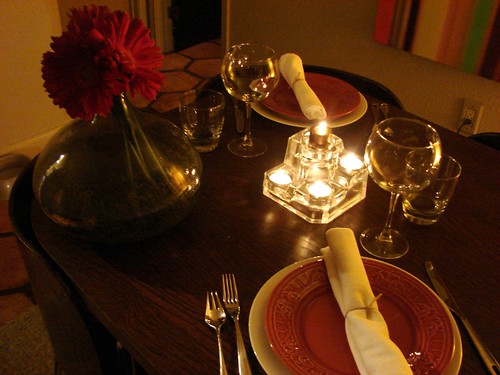
Want to know what was on the menu?
Tomato & Avocado Salad
Pan Seared Scallops with Red Pepper Confit
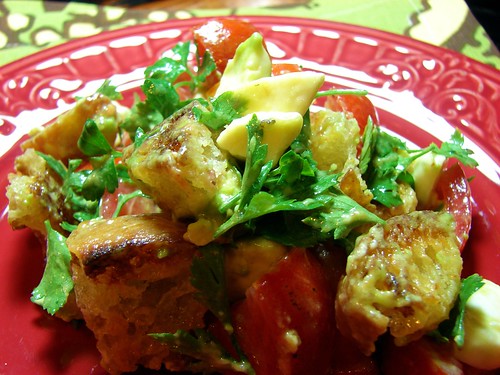

I can’t really explain how incredibly good these were, and so easy to put together. The salad was a no-hassle toss together kinda deal, and the parsley made it so fresh and crisp. Then the red pepper confit was out-of-this-world good. I swear I could take a tub of that and eat it on its own!
For the salad:
Cube 4 slices of ciabatta (or other bread you like) into 1-inch cubes and toast them in a nonstick skillet with some butter and olive oil. Set aside and allow to cool.
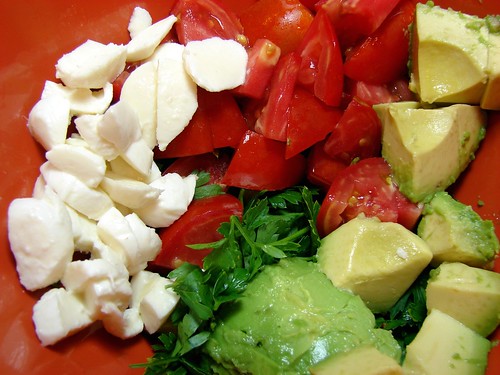
In a bowl, combine chopped
Tomatoes (I used 3 small ones)
1/2 avocado
1/2 cp fresh mozzarella
about 1 cp fresh Italian parsley (tear the leaves from the stems)
Add the cooled bread and toss with 2-3 tbsp of your favorite vinaigrette. Serve immediately.

For the Red Pepper Confit:
2 large red peppers
about 1/3 cp extra virgin olive oil
2 cloves garlic crushed
1/2 red onion (or yellow)
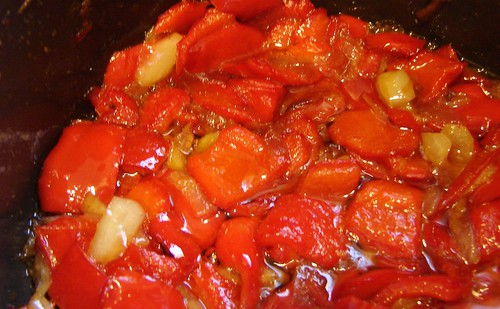
Add all the ingredients to a medium saucepan over medium heat and cook until the peppers have softened completely (about 30 minutes). Allow it to cool for about 15 minutes before pureeing it–use a blender or a small food processor.
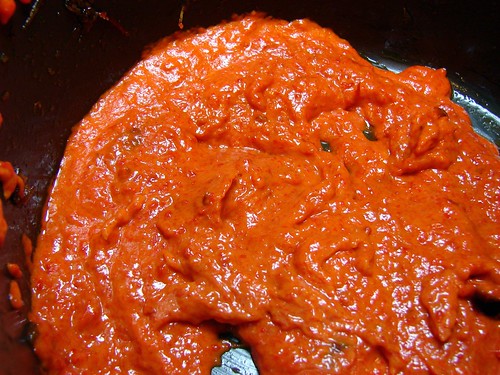
Return it to the saucepan and add a bit of broth or water to thin the puree. Keep warm while you cook the scallops.
For the scallops:
10-12 scallops (these were medium-sized)
rosemary stems (remove the springs and save for future use)
salt & pepper
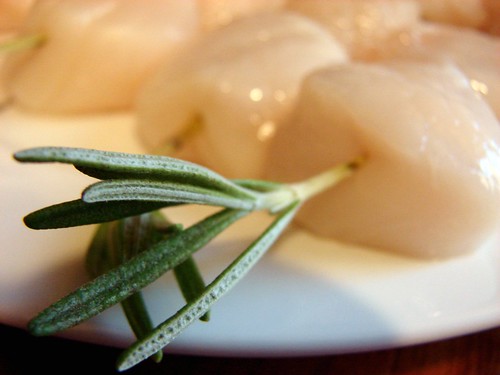
I used the rosemary stems and skewered 2 scallops on each one. You can skip this step if you want. Heat a nonstick skillet on high and add about 1 tbsp of oil. Make sure the scallops are dry and sprinkle with a bit of salt & pepper and sear them on the skillet. About 2 minutes per side, should be enough for medium-large scallops. Set aside and keep warm.
To plate: I wanted to preserve the crust on the scallops, so I blanched a few asparagus spears to put between the sauce and the scallops. Spread about 2 tbsp of the pureed confit, lay a few asparagus, then top with the scallops.
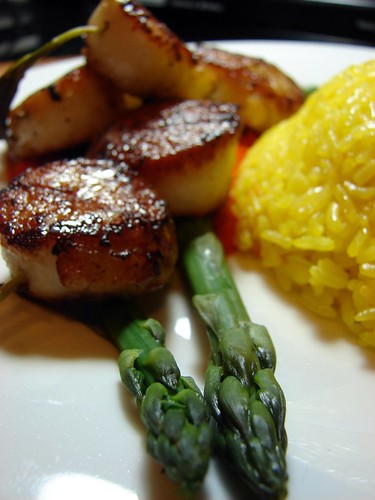
Happy Anniversary, Papucho!
Cookingly yours,
Anamaris

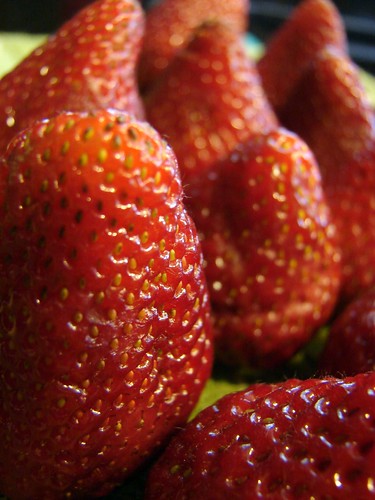
NYC is one of my favorite cities. EVER. I love everything about that place. I was lucky enough to have friends who lived in and around the city, so I got visit quite often. Each time I went, I would be in search of the ‘best of…’ something. One year, for a NYE visit, it was the best whiskey sour. Don’t know, don’t ask. I was younger then. Another trip was the best pizza. And another it was the best cheesecake. You get the drift.
I love cheesecake. Not the fancified, flavorfied kind. Just the basic NY cheesecake with either cherries or strawberries on top. I don’t remember where I had the best cheesecake on that particular trip. Probably because the memory was banished with all the brain cells I killed with alcohol that weekend. Nonetheless, cheesecake continues to be one of my guilty pleasures.

Years ago I realized that Cheesecake Factory cheesecake met my needs. I like their cheesecake. It is dense but not too heavy, sweet without being overpowering. I don’t always want to get dressed for cheesecake, though. And the only CF location here in Houston is ensconced in the Galleria mall, a destination omitted from my ‘must go’ list.
Here’s a recipe I’ve made over and over, I got it from one of the morning shows years ago. It is super easy and even more delicious. If you love cheesecake, you’re gonna love this one.
As Good As Cheesecake Factory Cheesecake
For the crust:
3 cps cookie crumbs (whichever ones you like)
¼ teaspoon ground cinnamon
1/2 cp (1 stick) softened butter
Preheat oven to 475°. You will need a 9-inch spring form pan and another pan large enough for the springform pan to fit inside to use as a water bath. Fill the large pan with about ½-inch of water, and place it in the oven while it preheats.
Line the bottom of the springform pan with parchment or wax paper and wrap a large piece of foil around the bottom (outside of the pan) This will keep any water from seeping through while the cheesecake is in the oven.
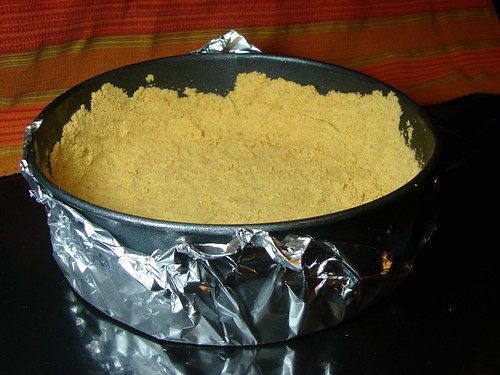
Combine the cookie crumbs and cinnamon in a medium bowl, before working in the softened butter.Press the crumb mixture into the bottom of the pan and sides of the springform pan. You can use something flat, like bottom of a glass to press it evenly. Place the crust in the freezer until the filling is done.
For the filling:
4 8-oz pkgs. cream cheese
1-¼ cps granulated sugar
½ cp sour cream
1 tsp vanilla extract
1 tsp almond extract
5 eggs
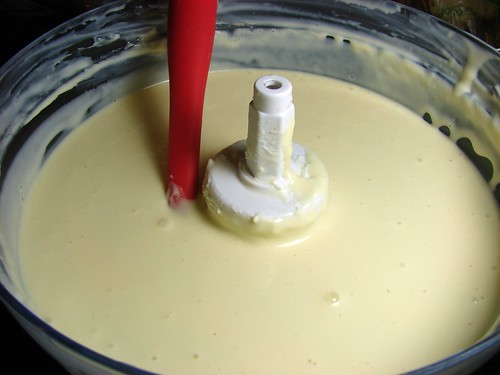
Use a mixer or food processor to combine the cream cheese, sugar, sour cream, and extracts. Scrape down the sides of the bowl and continue to blend until these ingredients are smooth. Add the eggs one at a time, making sure they are well mixed into the batter before adding another. Pour the filling into the cooled crust.
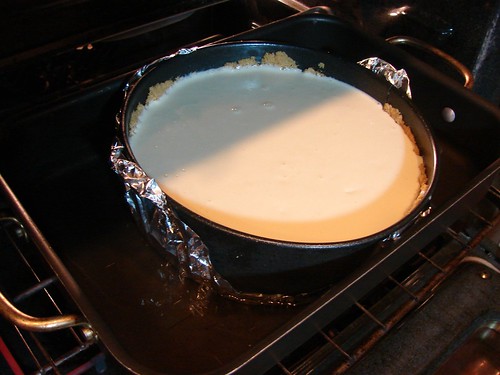
Place the cheesecake in the water bath, be careful not to burn yourself, but also not make sure you don’t splash water onto the cheesecake. Bake at 475° for 1o minutes before lowering the temperature to 350°. Continue to bake for 50 to 60 minutes or until the top of the cheesecake turns a light brown or tan color. Remove the cheesecake from the oven and water bath and allow it to cool for about an hour.

Cover and chill the cheesecake in the refrigerator for at least 6 hours, preferably overnight. Serve with your favorite fruit topping or just whipped cream. Strawberries are in season, so I made a bit of coulis and spread it over the top of the chilled cheesecake before covering with sliced berries. This recipe is enough for 12 generous servings.
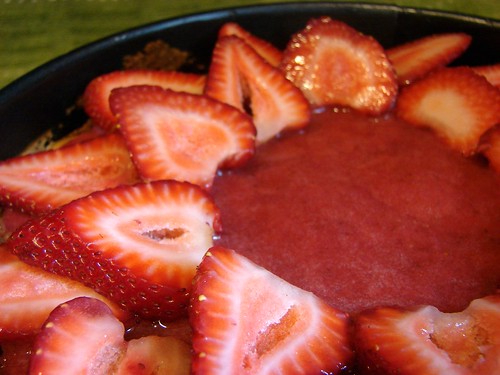
Enjoy!
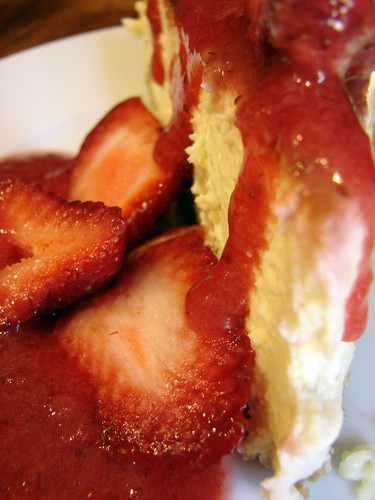
Cookingly yours,
Anamaris
My family is large. HUGE, which is a requirement for any good, self-respecting Latin family. We, Hispanics/Latinos, don’t differentiate between immediate and extended family. Are you kidding? We don’t even have to share the same bloodline! It’s not unusual to have ‘Tias y Tios’ (aunts and uncles) everywhere. The lady at the school cafeteria line, a parent’s childhood friend, basically anyone you see on a regular basis becomes part of your family.
My mom has 10 siblings, there’s a 20 year+ gap between the eldest and youngest. Her siblings had an average of 3 kids each, some of their kids have aunts who are younger than them. And when they all come together in one space, it really is an experience. The Hubbz was fascinated by how many conversations go on at once and people don’t have to be standing next to each other to be part of it.

Mami y Papi
My aunt Linda was explaining all the family idiosyncrasies to The Hubbz. All about the age difference between them, why my youngest aunt said ‘she didn’t know her oldest brother’. Linda and Lidia explained that the older siblings (my mom is as close to the middle as you can get) generally speak to each other in English, but the younger lot prefers Spanish. There were stories about my grandfather who passed away when I was 7, stories about me growing up, stories about my grandmother’s antics–she’s a real pistol, that one. Stories about life and family, the young and the old.

From left: Mami, Linda, Bubbles, Marcelina
Who knows what the Uncles were talking about, but they were gabbing it up.

Just like my mom’s family, there’s a nice age gap between myself and my siblings. My sister Magali is 5 years older, while my brother Almet is 15 years younger than me! He was only 7 when I moved to Houston, so he grew up and I didn’t witness much of it.

My sis has 3 girls: Kamaris, Karina and Katherine and 2 grandkids. That’s Anthony, giving me the angry face in the picture. Isn’t he sweet? The next picture is my brother Almet and his wife Vicki, they’re still newlyweds.
And these are my 2 youngest nieces, Katherine (blue top) and Karina. Top Model material, both of them. If there’s a camera within a 2 mile radius, they’ll be ready for it.

This is just part of what I consider my immediate family. On this visit I only saw 2 of my cousins when my mom threw a breakfast filled with Panamanian goodies. That was fun, made me think of Sunday dinners. Now you’ve met some of my peeps. My loved ones in far away lands. A piece of my heart.
Speaking of Sunday dinners. We ate A LOT of really good fun in Panama. Lots of it. All kinds of it. Check out the foodstream, it will make you hungry, I promise. I will post about specific dishes as I recreate them, but for now, a picture really is better than 1,000 words.

Tortillas y chicharron!
Anamaris
 Another month, another group bake. This month the Mellow Bakers are working on pizzas, among other breads. I love pizza, well, I love pizza crust. But it is tough to find one that love. There’s a pizza place that’s been around for ages, Antonio’s Flying Pizza has, quite possibly, the best pizza in Houston. Hand-tossed, with a crisp, thin center and pillowy, chewy edges. They also have an awesome sauce and DO NOT overuse it. OHMY!
Another month, another group bake. This month the Mellow Bakers are working on pizzas, among other breads. I love pizza, well, I love pizza crust. But it is tough to find one that love. There’s a pizza place that’s been around for ages, Antonio’s Flying Pizza has, quite possibly, the best pizza in Houston. Hand-tossed, with a crisp, thin center and pillowy, chewy edges. They also have an awesome sauce and DO NOT overuse it. OHMY!
Well, thanks to Mr. Hamelman, I’ve found the 2nd best pizza crust. It’s on page 273 of his book Bread. I thought this was a good opportunity to have a few friends over and see what would happen when I tried my hand at pizza-making. Let me tell you, it went VERY well. I’ll walk you through it.
The dough starts off a day in advance with the fermentation of a biga. A biga is a pre-ferment. This produces organic acids which significantly contribute to the structure and development of the dough and, ultimately, the rise and flavor of the bread.
In this case, the biga needs to develop for at least 12 hours, mine went for a little over 16. I have to confess, though, this biga was quite different from the ones I’ve made thus far. It actually freaked me out! First, it was a VERY tough dough, the pre-ferments I’ve done before were anywhere from runny to medium-stiffness. Second, it rose like gangbusters! Within 3 hours it had tripled in size. Previous ferments developed very slowly. To avoid what I thought might’ve ended up being over-development, I put it in the fridge overnight and removed it a couple of hours before I was ready to make the full dough.
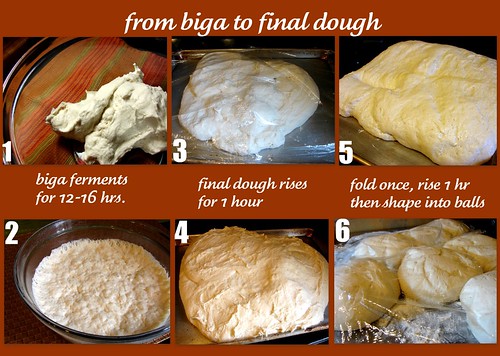
Crisis averted, I began working on the final dough about 3-4 hours before my friends were to arrive. Per the formula (that’s what they call bread recipes, how very scientific!), the dough needed to rise for about 2-1/2 hours before baking. Friends were due at 8ish, I began the dough around 3ish.
I opted to half the baker’s recipe, so I ended up with 5lbs of completed dough, which was then divided into 13 balls weighing approximately 6.5 oz each to make small personal pizzas. The collage shows the steps necessary prior to adding toppings and baking.
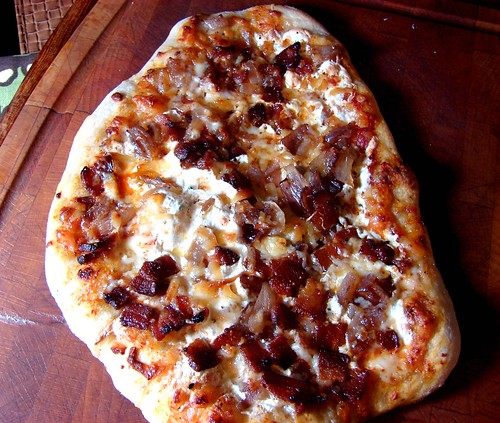
The oven is preheated to its maximum, 550° in mine, with the baking stone/pan left in the oven so it is smoking hot before the pizza goes on. A fellow Mellow Baker indicated they used the back of a cast iron skillet. This was a genius suggestion because we only have a medium sized pizza stone, but I do have large cast iron grill. And that’s what I used to bake these babies. Sprinkled some semolina on the stone and grill, then slid the topped pizzas over top.
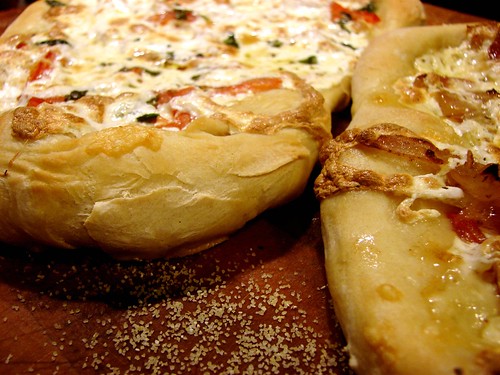
They baked for about 10-15 minutes and were perfectly delicious. Check’em out.

Cookingly yours,
Anamaris
I’ve been slow with this, VERY slow with this. But I’ve done it! I’ve selected my favorite shots: 85 of about 800, how crazy is that?
There’s a little of everything, except for food, I still need to work on those. There are straightforward shots of the sights, a few shots of things that caught my eye and some captures of typical Panama things.
I hope these give you a taste of my beautiful little country. Who knows? Maybe it’ll interest you enough to make it your next destination, you won’t regret it.
Here are just a few samples, click on any of the pictures or follow the link to my Flickr stream and watch the slideshow.
Enjoy!
Anamaris




This is a popular one, isn’t it? It seems everyone has heard of and/or had Arroz con Pollo at some point in their lives. The combination of rice and chicken seems to be present in most every culture, which makes sense when you think about it. Generally, both of the main ingredients are fairly inexpensive. It allows a cook to feed a large number of people with a small amount of ingredients, with a dish that still looks sensational.
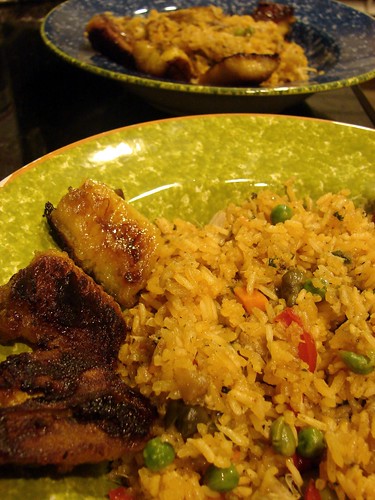
I’ve always loved Arroz con Pollo, I’ve had many variations of it. Some I liked, some I loved, some I didn’t. Over the years I’ve perfected mine by combining the winning factors of all the good ones I’ve had. Panamanians like their arroz con pollo with olives, capers and raisins. Yep, raisins. There is something really magical that happens when you have the briny flavor from the capers combined with the sweetness of the raisins. The dish is still savory, but it definitely gains some significant depth because of them.
It is a satisfying, easy and delicious family recipe, the kind that is prepared for special occasions. I usually make a large batch of it to make sure there’s enough for leftovers. By the way, it keeps getting better and better everyday after its made.
Arroz con Pollo (chicken and rice)
Serves 6-8
For the chicken:
8 chicken thighs
3/4 tsp sea salt
2-3 cloves garlic, crushed
1 tsp black pepper
1 packet Knorr Sazón
1 large onion, roughly diced
2 cps tomatoes, seeded and diced
1/4 cp cilantro, chopped
12 oz beer (preferably something robust like a medium lager)
For the rice:
1/2 large red bell pepper, sliced
3 cps long grain rice
4 cps broth (from the chicken)or water
Sea salt to taste
2/3 cp pimento olives
3 tbsp capers
2/3 cp seedless raisins
1/2 cp peas & carrots, frozen
1/4 cp parsley, chopped
Preparing the chicken
You will need a heavy-bottom, medium to large size pan with a tight-fitting lid; the dish is pretty much cooked in a single pot. First, season the chicken with the first 4 ingredients. I prefer cooking the chicken with its skin, it adds flavor and makes the addition of oil unnecessary for this step. You can remove the skin once the chicken is cooked. If you opt to use breast instead of thigh meat, I will highly recommend keeping the skin to help keep the meat moist.
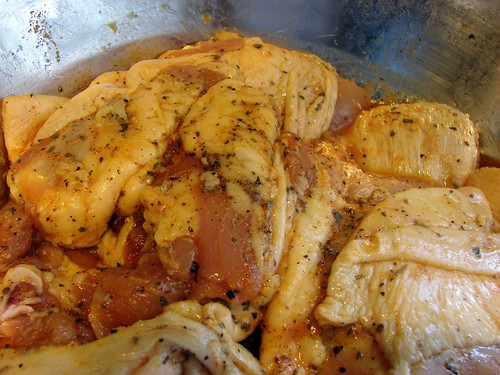
Heat the pan over medium-high heat and brown the chicken pieces in batches, if necessary. Once the chicken has been seared on both sides, remove and set aside. Remove any excess fat from the pan, leaving about 1 tbsp, but do not discard the rest, you will use it to make the rice.
Add the onions and tomatoes, scrape the drippings stuck to the bottom of the pan. Add the cilantro and beer. About the beer; we generally have robust beers at home, such as Modelo, Blue Moon, Sam Adams, Grolsch. I find these are great for cooking, because they’re so flavorful. Use what you have around, just avoid anything light, if possible.
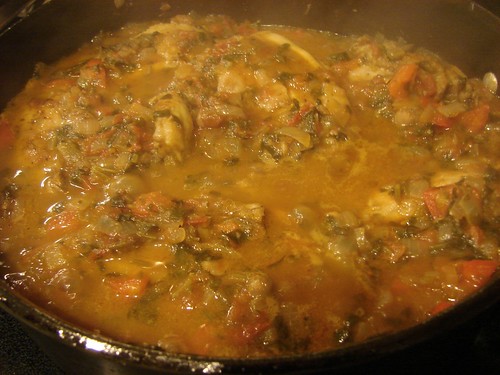
On with the cooking. Once the beer has started to boil, return the chicken pieces to the pan and make sure to add any juices that came out of the chicken. Lower the temperature to medium-low, cover with a lid and simmer for about 25 minutes or until the chicken is very tender. Once the chicken is cooked through, remove the pieces and allow them to cool before removing the meat from the bone. Drain and reserve all the cooking liquid from the pan, set aside.
Preparing the rice:
Rinse the pan and heat it over medium-high heat. Add 3 tbsp of the reserved fat and saute the red pepper until tender. Remove from the oil and set aside. Rinse and drain the rice, add it to the pan, stirring to coat it with the oil. Make sure to stir continuously for about 3-4 minutes. Now add enough water or chicken broth to the reserved liquid to make 4 cps, add it to the rice, season as needed. Bring it to a boil without disturbing it.

Once the water is almost completely evaporated, reduce the temperature to low and layer the previous ingredients. First the olives and capers, then the shredded chicken and peas & carrots, finally, top with the raisins and peppers. Cover with the lid and allow the rice to cook/steam for 30 minutes.
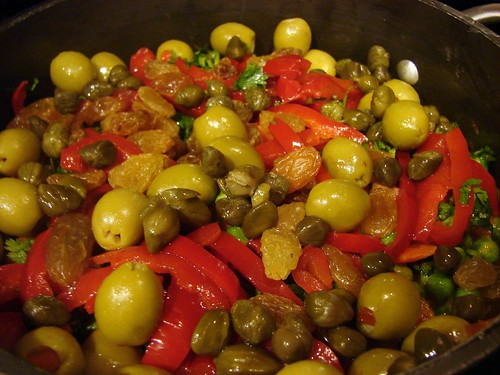
At the end of the 30 minutes, stir the chicken and vegetables into the rice and serve.

Cookingly yours,
Anamaris
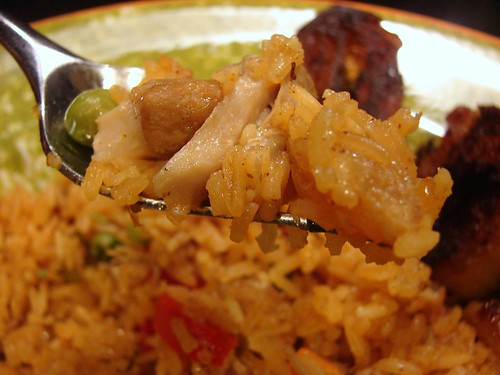
I can’t tell you when was the first time I had a taste of this magical dessert, but I CAN tell you it’s been one of my favorites ever since. And when I realized how simple it is to make, it was all over. I don’t make it often. Not because I don’t want to, it’s because I would require a crane to leave home IF ever I did. “When” I do make this thing, I eat most of it all.by.myself. And I reserve the right to begrudge anyone who dares have some.

The debate over the origins of this little treat will likely continue ’til kingdom come. And why not? I would totally claim it as my own! I mean, this thing is perfection on a spoon or fork. In any case, rumor has it the dessert originated in Nicaragua, so that’s the story I’m sticking to. It is possible that the recipe was featured on the label of Nestle’s evaporated and condensed milks in the early 1900s. A clever marketing move that may be responsible for one of the most coveted desserts around.
Let me count the ways I love theeez here dessert. It’s super moist. Light and dense all at once. It is served cool. It isn’t overly sweet (depending on the baker’s preference). And the cream can be flavored with almost anything you’d like. Me myself, I prefer the basic vanilla-ey recipe. Call me a prude if you must, but I like what I like. I’ve tried variations of it flavored with chocolate. I’ve heard of adding coconut milk (that one intrigues me), but I’ve not made either of those. I do, from time to time, add a bit of alcohol–bourbon, Amaretto, rum. I also prefer to flavor the sponge cake with almond extract instead of lemon extract.
Ok, I’ll shut up now and give you my version of it. Most recipes will suggest equal amounts of milk, but I find that ends in a very sweet cake. I’ll still eat it, but I can eat a LOT more of it when the sugar content is toned down, so I add more of the evaporated milk and heavy cream. Also, even though I’m a big proponent of generic brands, I must admit that when I make this one, I go for a well-known brand name. It may be in my head, but I won’t take any chances when it comes to my tres leches.
Pastel de Tres Leches
For the sponge cake:
6 eggs, separated
1 cp all-purpose flour
¼ tsp salt
1 cp extra fine sugar
1-1/2 tsp vanilla extract
1 tsp almond extract
Preheat oven to 350°. Separate eggs and place the yolks in the bowl of your mixer. Beat the yolks until they change to a creamy yellow and are the consistency of yogurt. While the yolks are beating, sift the flour and salt together and set it aside.

Remove the yolks from the bowl and set aside. Make sure to wash the bowl and beaters very well before adding the egg whites; this is important because if there’s any residue of the yolk, the whites will not stiffen into a meringue. Beat the whites until they form soft peaks, adding the sugar a couple of tablespoons at a time. Add the almond and vanilla extract.
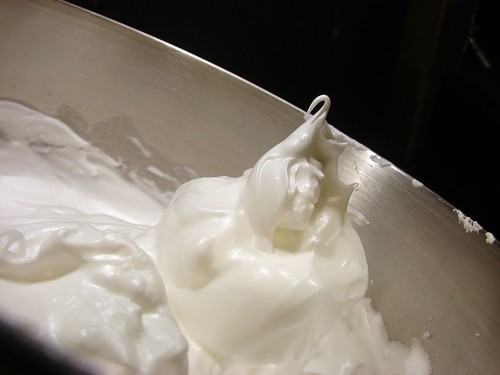
Fold in the egg yolks until evenly incorporated. The purpose behind folding egg whites into a batter, is to end up with a batter that is airy and light. This is a good how-to link.
Once the eggs are incorporated, fold in flour a bit at a time. Make sure to check the bottom of the bowl for any flour that may have found it’s way to the bottom.
I used a generously buttered (not floured) 9-1/2×14″ Pyrex to bake this. It makes it convenient, it bakes and works as a serving dish to keep all that milky goodness in place. Bake at 350° for 20-30 minutes or until a knife/toothpick comes out clean when inserted in the center. While the cake is baking, prepare the milk bath.
For the milk bath:
1 can (12 oz) evaporated milk
1 can (14oz) sweetened condensed milk
2-1/4 cps evaporated milk
2-1/2 cps heavy (or whipping) cream
1 tsp vanilla extract
2 tbsp bourbon (or your preferred liquor) optional
Combine the evaporated milk, condensed milk, cream, vanilla and alcohol in a mixing bowl. Whisk until well blended; the condensed milk will tend to hang out at the bottom of the mixing bowl.
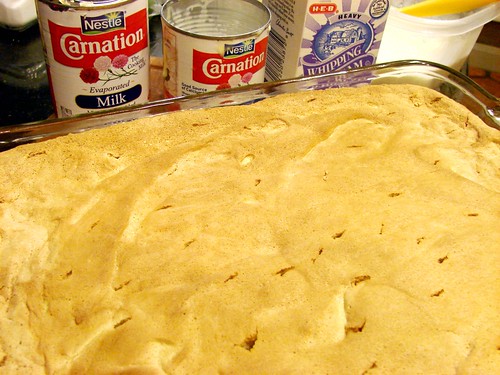
Once the sponge comes out of the oven, pierce holes all around the top. Give it about 10 minutes to cool then invert it onto a tray lined with wax paper, pierce holes on the bottom cake. You can use a fork or a small knife for this task. Before returning the cake to the baking dish, use a paper towel to wipe any butter that may have dried while baking. Pour half of the milk bath into the baking dish, then place the warm cake bake into the dish. Pour the rest of the milk bath over it. At this point you may have to wait a few minutes to allow the cake to soak all of the milk before adding any more.

Once all the milk has been added, cover loosely with plastic wrap and refrigerate for at least 3 hours or overnight. IMHO, the longer you allow it to cool, the more enjoyable tres leches becomes.
Note: If you have a deep-lipped serving dish, you can use it to add the milk bath and as your serving vessel. I usually leave my tres leches in the container I use to bake the sponge cake.

If you wish to top it with a frosting of sorts, you can opt for a plain meringue–this seems to be the traditional topping. I don’t like it. Instead I whip more heavy cream, about (1-1/2cps) and fold in 2-3 tbsps of condensed milk. You could add sugar, 2-3 tbsps if you don’t have any condensed milk left. Spread the topping over the cooled cake. Serve and wait for the sounds of pure enjoyment.
Cookingly yours,
Anamaris
I like bagels. I won’t say I love them, because it’s not that intense between us. I don’t eat a lot of bagels because I have a tough time finding bagels that balance chewiness with the necessary crust. But when the Mellow Bakers added bagels to April’s lineup, I knew I was gonna try them.
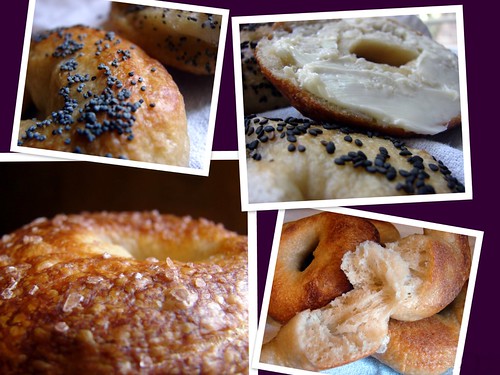
Yes, I’m behind on this submission. I’ve been busy traveling. The good news is, this is a relaxed baking group, hence the name, Mellow Bakers. I had to order things I’d never heard of such as diastatic malt powder and syrup. I also got some of that coveted high gluten flour because I’m pretending to be serious about this bread making business.
I started the dough yesterday and was immediately struck by the scent of yeast. I’ve decided it is one of my favorite smells now. Slightly sweet, with an underlying pungency. Filled with the promise of glorious bread. Yep, I’m digging the breading.
I followed most of Mr. Hamelman’s instructions for the home batch, but added a bit more salt because I use sea salt instead of the regular stuff and about 1-2 tbsps more water to keep the dough pliable. I also allowed the dough to ferment a bit longer before shaping, an extra hour to be exact.

This is the first time I weighed dough before shaping. Hamelman suggested making each bagel with 4 ozs of dough, but I wanted mine just slightly smaller, so I weighed to 3ozs and ended up with 22 bagels.
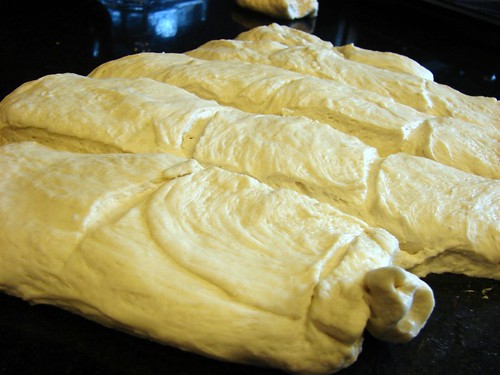
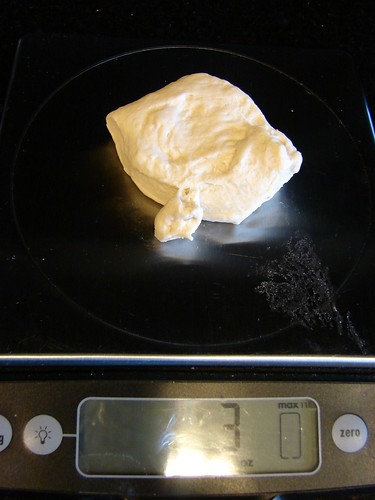
When it came time to shape them, I tried both methods: rolling and poking.
Rolling and wrapping: roll each piece of dough to about 6-8 inches long, then wrap it around the broadest part of your hand slightly overlapping the ends. Roll your hand back and forth on the counter to seal the ends together.
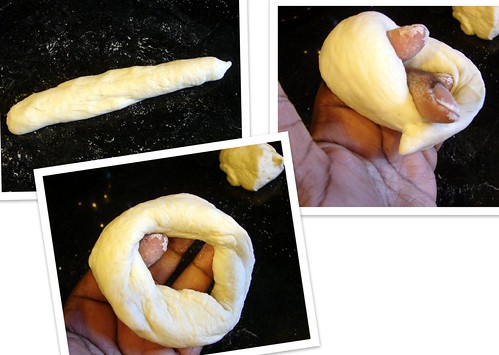
Poking: shape the dough pieces into tight balls, poke a hole in the center with your thumb. From the center gently pull until you have a nice size hole in the center.

Place the finished bagels on a sheet pan that has been sprinkled with cornmeal. Cover with plastic wrap, they’re now ready to be stashed in the fridge overnight or at least for 6 hours.
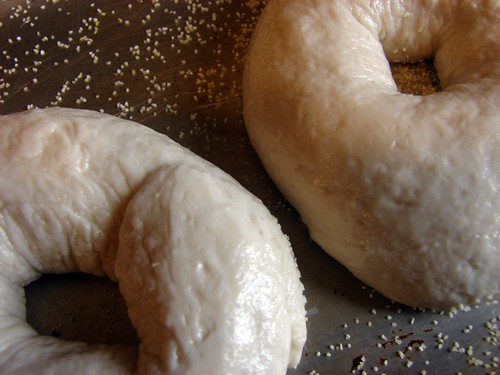
The next day when you’re ready to bake, preheat the oven. The book suggested taking it to 500°F, but I’ve noticed that when I heat the oven that high, it browns my breads too quickly, so I went for 475° and placed my baking stone on the first rack.
First step requires the bagels to be boiled. I added malt syrup to a large stockpan filled with water and brought it to a boil. I used enough syrup to make the water look like strong tea. The idea behind this step is to reactivate the yeast since it has been refrigerated for a while. The other benefit of this step is to gelatinize the starch on the surface so you end up with beautifully chewy bagels.
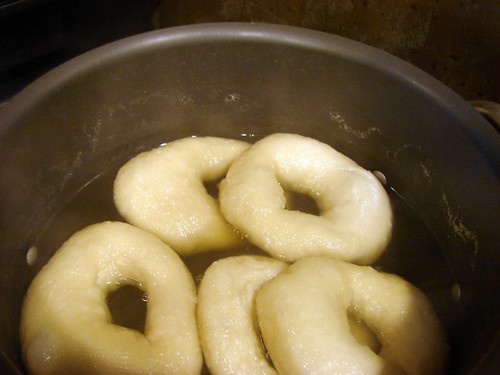
I had the benefit of reading the comments from other bakers before I began my bagel process, so I learned from some of their challenges and took some precautions or made some changes. The first change was to pull the bagels out of the fridge and allow them to slowly come to room temperature. This wasn’t intentional, but I noticed that the bagels I boiled & baked last were a lot puffier than the first batch. Since I didn’t have a bagel board, I boiled & baked in batches of 5-7 bagels at a time.
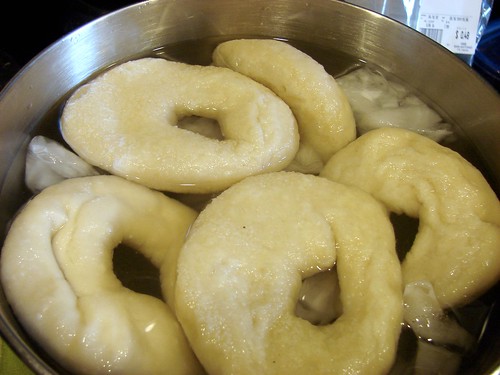
Also, instead of leaving them in the water for 45 seconds as suggested in the book, I allowed them to stay in for a few minutes until *I* noticed that they were swelling. Then I removed from the water and placed them in an ice bath as instructed for 3 or 4 minutes. Transfer them to a baking sheet/stone that has been sprinkled with cornmeal.
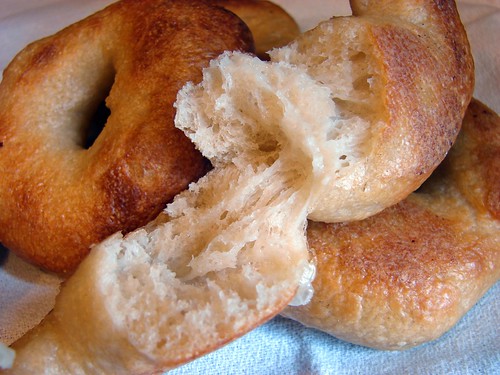
The first batch I made was plain, no toppings. For the second batch, I followed the same steps: boiling, icing, draining, but before placing them on the stone press one side into a plate of sesame seeds, poppy seeds, onion flakes, or seeds of your choice, then put them on the stone or sheet pan.
The instructions were to put the seeded side down and then flip the bagels halfway through baking. As a matter of fact, the instructions are to flip them regardless of topping or not. I didn’t like the way the looked after flipping, they seemed flat and distorted. I’m probably doing something wrong, but I liked them best left alone. I baked the topped ones with the topping on top and simply rotated the stone at 5 minute intervals. They baked for a total of 15 minutes or so.
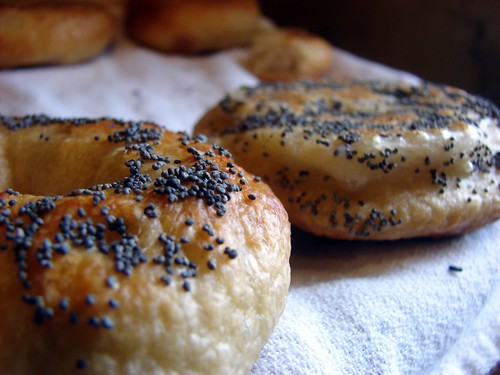
In the end, the bagels were chewy and crusty, just the way I like them. On the last batch, I noticed that while boiling, some of the surface gets very thin–gelatinous and it can burst allowing water to hide inside. In those cases, the center was a bit doughy. I caught on the very last batch and made sure to drain that water out before putting the bagel on the stone.
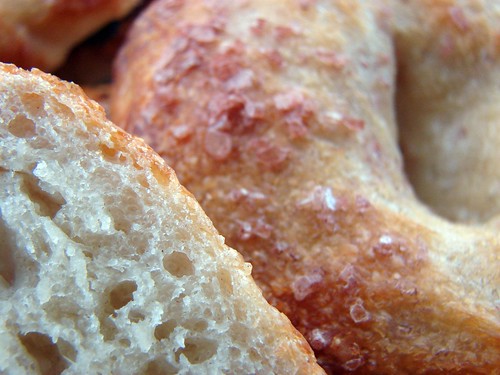
I’m so glad I tried these. I’m a happy bagel camper and if you’d like to check out the bagels by some of my other mellow cohorts, follow this link to the bagel gallery.
Cookingly yours,
Anamaris
This is a popular dish in Panama, you’ll often see it served for breakfast with a fried egg–then it becomes Bistec a Caballo. Caballo is a horse and I have NO idea why the mention of a horse is necessary, but I don’t make up the names, I just eat the food.
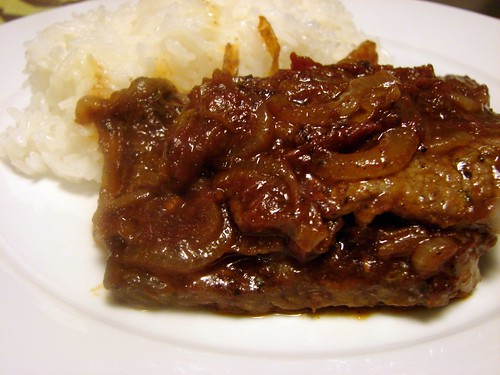
The beef used for this is a cheap cut, no fancy meats and it is then drizzled with pan juices. For breakfast, this will be accompanied by hojaldas or tortillas, otherwise, white rice and tajadas are the right companions.
I’ve improved the dish by cooking the beef a to medium rare and because The Hubbz needs a bit of gravy/sauce, I added pureed tomatoes to maximize the pan juices. This is not a recipe, there’s no need for one, what I’m offering is a step-by-step guide. Adjust as necessary.
Bistec Encebollado
You will need:
About 1 lb beef round tip
Sea salt
Black pepper
Onions
Crushed garlic
Oregano
Olive oil
Fresh tomatoes
Crushed tomatoes
I used slices of round tip, about 1 lb of filets 1/2-inch thick. I took a mallet to them to make the slices uniform and to tenderize it a bit. I ended up with slices that were about 1/4-inch thick and cut them into medallions that were about the size of my palm.
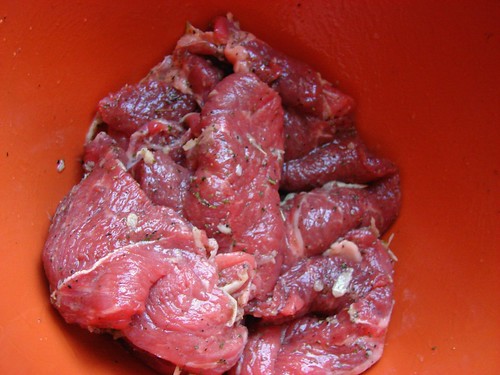
Season with salt, black pepper, crushed garlic, oregano and olive oil. Set aside while you prepare the rest of the ingredients.
Slice 2-3 medium onions, if you like onions, you can’t have too many. Slice them into rings about 1/4-inch thick. You will also need 1/2 a red bell pepper diced. Substitute with green pepper if you can’t get your hands on red or skip it all together. Remove the seeds from a Roma tomatoes and dice finely.
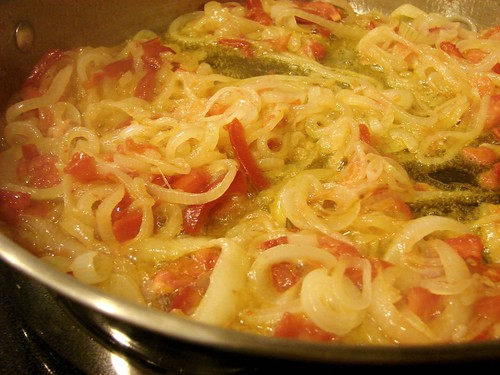
In a large skillet, heat about 3 tbsp of olive oil and add the onions, cooking them until they start to become translucent, then add the bell peppers. Cook for a couple of minutes before adding the tomatoes and 1-2 tsps of white vinegar. Cover and cook for another 3-5 minutes. Allow the oil to drain, remove from the skillet.
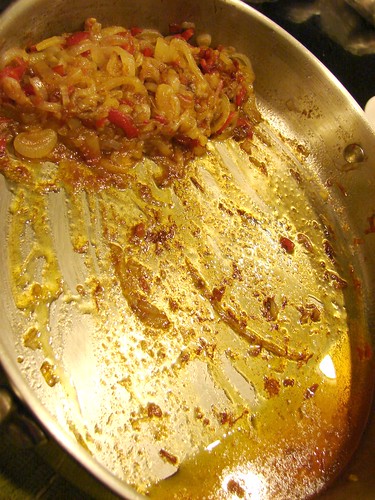
Heat the skillet and oil, brown the medallions in batches. Make sure not to crowd them or you’ll end up boiling them instead of searing. Cook them to the desired doneness, remove and keep warm until all the beef is browned.

Return the onion mixture to the skillet, add a bit of liquid (wine, sherry, beer, stock, water) to loosen the bits before adding about 1 cp of crushed tomatoes. Adjust seasoning, allow it to cook for about 3 minutes, then add the slices of beef turning them into the sauce. Turn off the heat.
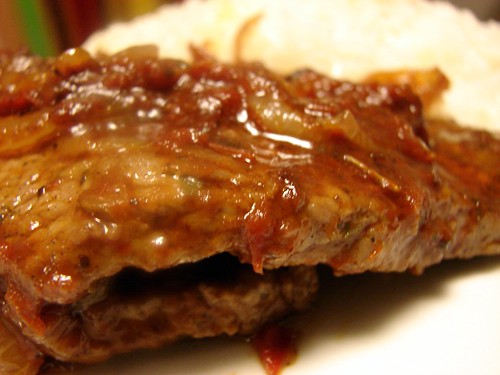
Serve with rice and tajadas.
Enjoy!
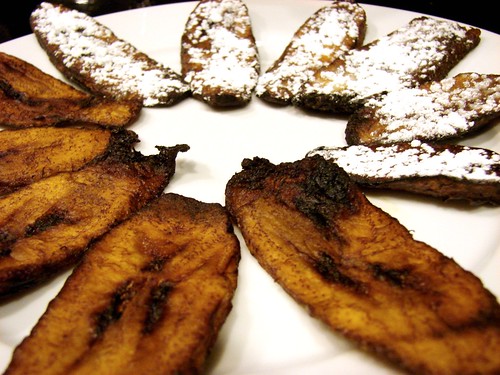
Cookingly yours,
Anamaris
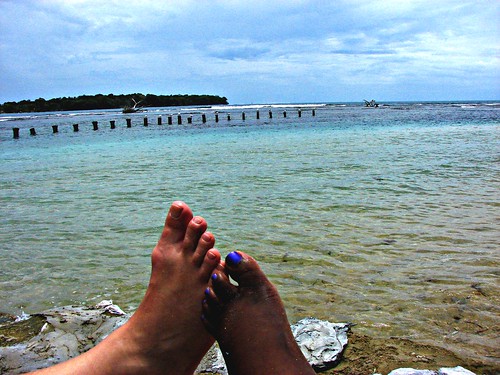
I’ve got Panama on the brain. It’s always in my heart, obviously, but I’ve not been able to get it out of my temporal lobe.

It may have something to do with the fact that we brought back so much of what we enjoyed there. I grabbed as many bottles of Seco Herrerano and D’Elidas hot sauce as we could fit into suitcases.

Pineapple juice & Seco. Oh Yeah!
I know have close to a hundred packets of El Arrocero, tons of corn tortillas and empanadas, chorizo…, yeah, I went nuts at the grocery. Oh. COFFEE. I brought bags upon bags of Café Durán. THE best coffee ever in the history of humanity and coffee.
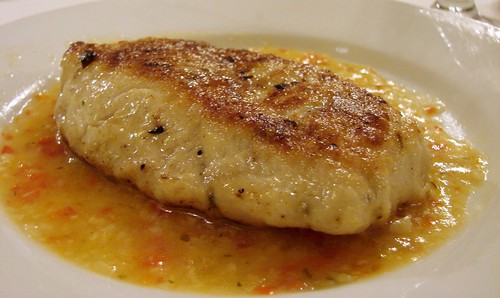
Las Tinajas' Corvina al Ajillo
Sunday I made Camarones al Ajillo (shrimp in garlic sauce) tweaking the garlicky sauce a bit to resemble the one served in every restaurant where we had Corvina al Ajillo (croaker in garlic sauce). The sauce is thicker and includes red bell pepper. Since I hadn’t made it to the store yet, I didn’t have bell peppers, but I added a bit of flour to start a roux and thicken the sauce. Other than that, I followed the recipe. Yum!
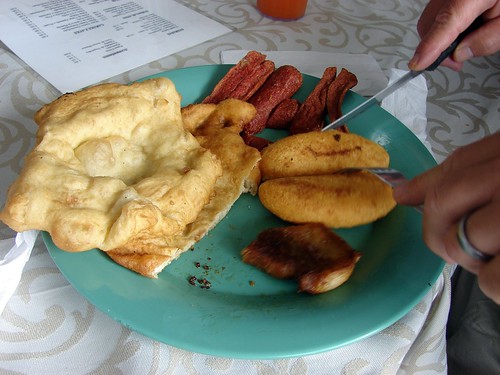
Breakfast at El Montuno
Monday I pan-fried thick pork chops and served them with tons of caramelized onions, a lazy ode to an encebollado using what was still in the fridge. That was served with Hojaldas (hojaldre), a traditional Panamanian fried bread popularly served for breakfast and evening snacks.

Last night I went for the traditional Bistec Encebollado. I added crushed tomatoes to accommodate The Hubbz need for a sauce. This was served with plain white rice–though there’s nothing plain about it-and Tajadas, sweet plantain slices that are fried to enhance and caramelize their sweetness. That recipe is here.
Is it any wonder I can’t get Panama out of my brain?

Cookingly yours,
Anamaris





































































